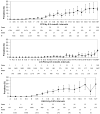HbA1c as a Diagnostic Test for Diabetes Mellitus - Reviewing the Evidence
- PMID: 24151343
- PMCID: PMC3799221
HbA1c as a Diagnostic Test for Diabetes Mellitus - Reviewing the Evidence
Abstract
The evidence base in support of HbA1c as a diagnostic test for diabetes mellitus is focused on predicting a clinical outcome, considered to be the pinnacle of the Stockholm Hierarchy applied to reference intervals and clinical decision limits. In the case of diabetes, the major outcome of interest is the long term microvascular complications for which a large body of data has been accumulated, leading to the endorsement of HbA1c for diagnosis in many countries worldwide, with some variations in cut-offs and testing strategies.
Figures
References
-
- World Health Organization . Abbreviated Report of a WHO Consultation. Geneva: WHO; 2011. Use of Glycated Haemoglobin (HbA1c) in the Diagnosis of Diabetes Mellitus. - PubMed
-
- d’Emden MC, Shaw JE, Colman PG, Colagiuri S, Twigg SM, Jones GR, et al. The role of HbA1c in the diagnosis of diabetes in Australia. Med J Aust. 2012;197:220–1. - PubMed
-
- Braatvedt GD, Cundy T, Crooke M, Florkowski C, Mann JI, Lunt H, et al. Understanding the new HbA1c units for the diagnosis of Type 2 diabetes. N Z Med J. 2012;125:70–80. - PubMed
-
- Kilpatrick ES, Winocour PH. ABCD position statement on haemoglobin A1c for the diagnosis of diabetes. Pract Diab Int. 2010;27:306–10.
Publication types
LinkOut - more resources
Full Text Sources
Other Literature Sources

